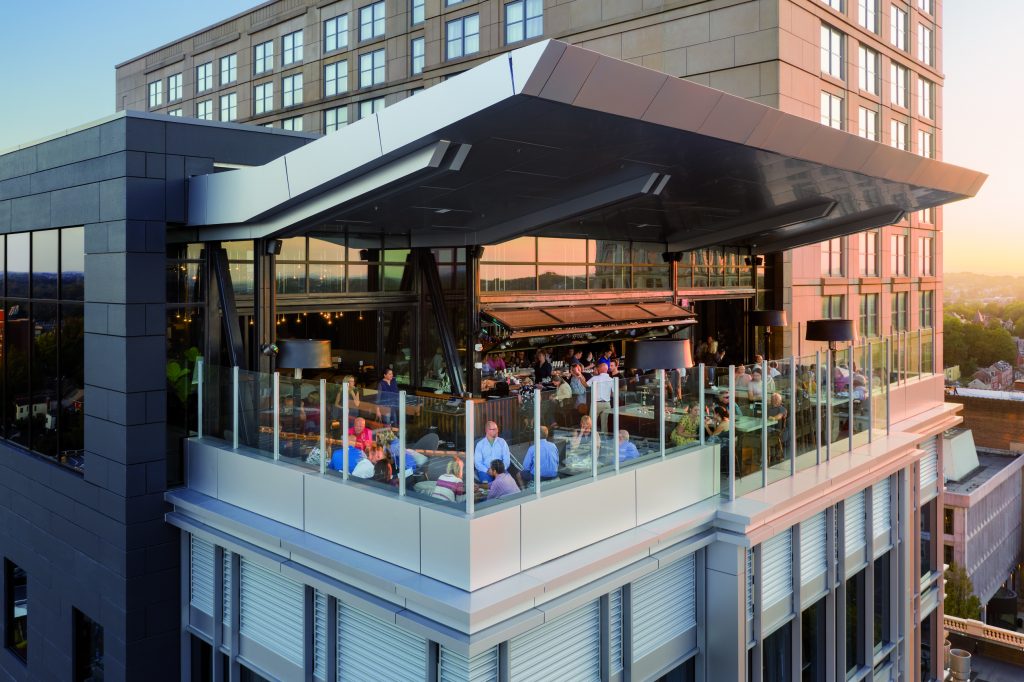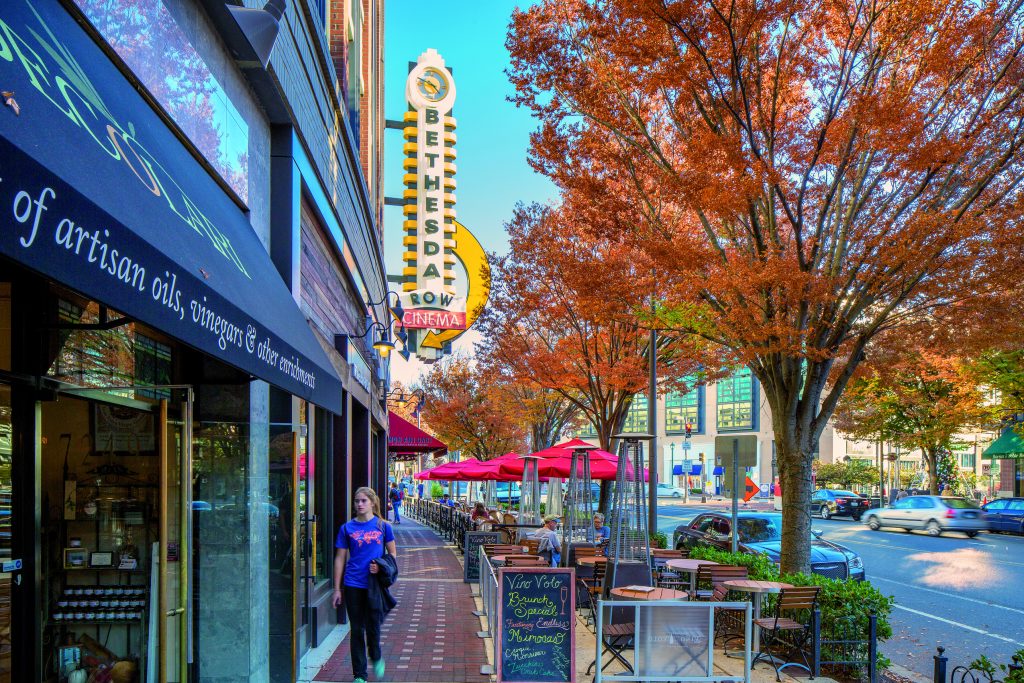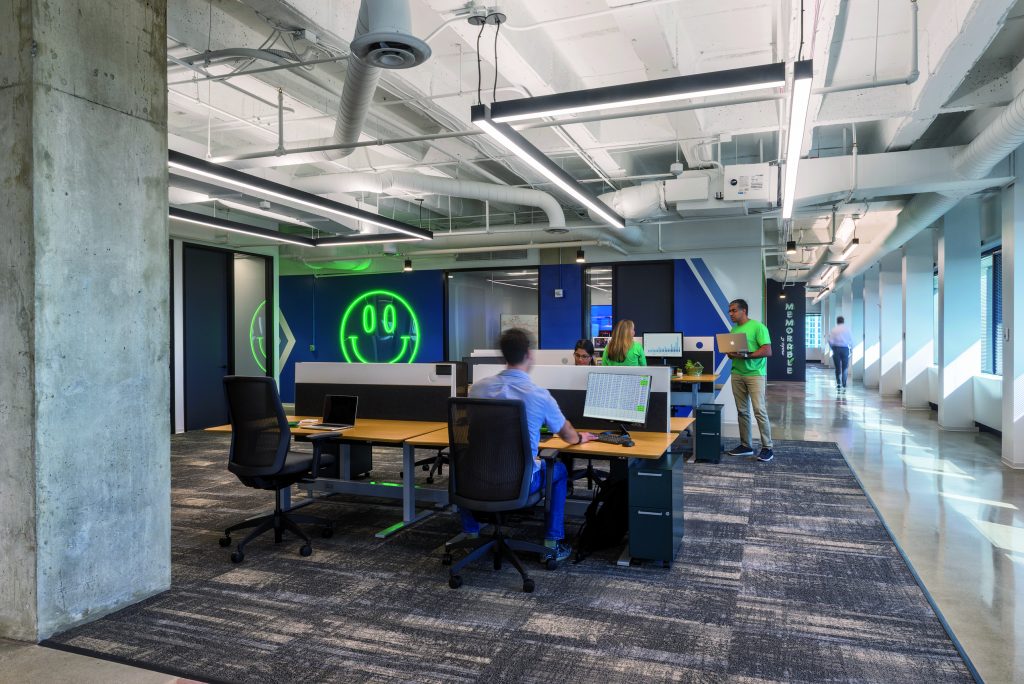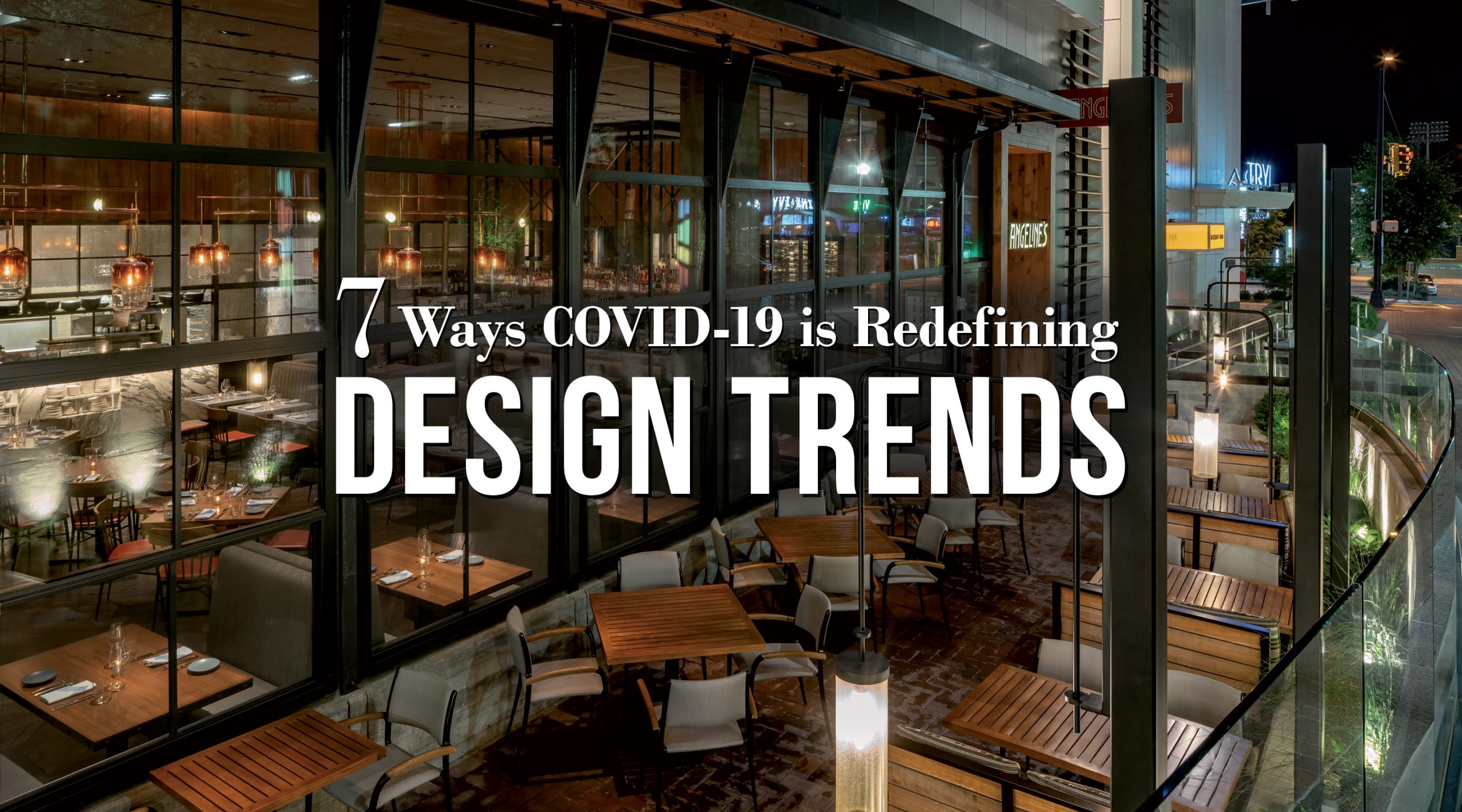Our built environment is an evolving reflection of society and human behavior. Just as the September 11th terrorist attacks forever altered the way we fly, the COVID-19 pandemic is perpetually changing the manmade places where we live, work and play. While this may sound bleak, we see beauty and new beginnings rising from this hardship in the form of seven design trends that are shaping up to be universal truths for how we approach design, no matter the building type.
These truths are informing our design decisions now and moving forward. They aren’t about tape on the floor, hand sanitizer stations or temporary sneeze guards (we don’t even use the phrase “social distancing” once in this article). These truths are much larger architectural influences that mark a turning point in history and a paradigm shift for design thinking. They include outdoor space, healthy buildings, the curbside experience, localism and community, contactless interactions, flexibility and circulation.
1. Outdoor space is supreme.
People have long gravitated toward well-designed outdoor space. Think of the incredible economic growth that’s already happened around trails like New York’s High Line and Atlanta’s BeltLine, the rise in popularity of rooftop spaces, and the Irresistible Stairs designed to promote healthy activity in Seattle’s Bullitt Center. The pandemic has only heightened this very human desire to be outside because it feels like a safe space where people can breathe easy (both literally and figuratively).
We see this trend playing out a few ways:
- Larger restaurant patios. In Georgia, one of the first states to reopen, many restaurants have started dine-in service again on patios. Some restaurants have even extended their patio seating into sidewalks and parking lots. Landlords are considering redrawing lease lines to accommodate more outdoor dining.
- Gardening space in residential communities so people can grow their own food and work towards self-sufficiency — a modern take on the Victory Gardens the government encouraged citizens to plant during World War II.
- Outdoor terraces and balconies in office buildings.
- More square footage dedicated to urban parks and greenspace. Real estate owners will be more motivated to invest in these non-revenue generating greenspaces because they are good for the neighborhood and add value to the property.
- Additional bike trails and walking paths stitching various neighborhoods together. News outlets have reported a bike boom over the last few months, with one headline reading: ‘Bicycles are the new toilet paper’: bike sales boom as coronavirus lockdown residents crave exercise.

2. Healthy Buildings Will Dominate
In recent years, trends surrounding wellness and healthy buildings gained popularity thanks in part to accreditations like LEED, EarthCraft and WELL. The COVID-19 pandemic creates a new reason for more building owners to not only seek out these certifications, but also for the standards associated with them to reach higher. We expect to see new technologies gaining in popularity like disease-killing UV lighting and modifications to our HVAC systems for cleaner indoor air.
Consider a doorknob. Technology for self-sanitizing fixtures or handles coated in antibacterial bacteria protection already exist. In the United States, these high-performing materials are typically only used in hospitals and healthcare facilities, however, imagine if these were used in all public spaces — from a subway to hotel lobbies to the entry to an office tower. While a higher cost and level of skilled labor come with them, Japan has taken similar provisions to implement broader use of these healthier materials and the U.S. could be next.
3. The Power of the Curb
Dining at neighborhood cafes and watering holes have been temporarily traded for food delivery, curbside pick-ups and Zoom happy hours. While restaurants — as well as grocery stores — have been increasingly experimenting with options for delivery and take-out, the pandemic has introduced new audiences and greater demand for these services. The curbside experience is now a critical design consideration.
Here’s how we see this trend playing out:
- Redesigned parking lots to accommodate more curbside pickup and delivery drivers.
- Multiple entries in big box retail stores so a customer can expedite a trip to the deli or the pharmacy without walking the length of the entire store.
- Urban plans with wider sidewalks and street grids designed with coveted, curb-facing property in mind
- Increased sidewalk and parking lot dining for restaurants. Tables and chairs that sit along the sidewalk curb, increasing pedestrian friendly environments in suburban downtowns.

4. Localism and Community Matter
As cases of coronavirus and shelter-in-place ordinances began to spread across the U.S., people filled their driveways, cul-de-sacs and porches. They held virtual dance recitals, storybook readings and cooking classes. They packed their local parks and trails. They even sang to each other and clapped for first responders from their individual balconies. People found a way to see each other safely – both virtually and in real life.
We expect to see a return to smaller, self-contained communities – whether they be urban, suburban or rural — with very convenient access to goods and services. Rather than destination parks, megachurches and regional superstores, we expect to see more micro parks, chapels, local shops and smaller grocery stores that serve the same neighborhoods. People know their neighbors again and likely a rebirth of suburban downtown neighborhood vitality
5. The Less We Touch, The Better
Imagine an experience where you don’t touch anything besides your personal belongings and the products you’re buying. This is where we are headed and it requires the implementation of new systems and design strategies, the possibilities are endless with evolving technologies and may include:
- Automated doors or foot operated door openers
- Card readers where the customer simply waves its phone or card above the payment reader
- Virtual hotel check-in and digital room keys that live on your phone
- Touchless elevator controls where your smartphone technology interfaces with the elevator to take you up to your floor.
- Doorless public bathroom arrangements in multi-tenant buildings similar to what we see in airports, public transportation centers and large arena settings today.
6. Good Space is Flexible Space
Across building types, this concept of flexibility and individual electability will become more valued for both the building owner and the people who inhabit it. Moving forward, coveted features in apartments could be adaptable furniture that transforms a living room, bedroom or closet into a home work space, or dedicated work nooks within a unit to provide privacy between roommates or family members working under the same roof.
In the same vein, companies whose employees were once reluctant to work remotely are getting acclimated with different technologies and virtual conferencing. What does this mean for the relationship between employees and office space? Recent trends of desk hoteling, electability and flexibility for ways people use a workspace are bound to continue as companies come to terms with which employees truly need to be in the office and when.
We may also see new-build hotels located near hospitals designed to more easily convert to step-down units if needed. In this scenario, there are much more than material choices (like the cleaner door handles) to consider, but also key structural components — like higher standards for air quality and electrical capacity, to name a few.

7. Circulation So Intuitive You Don’t Need COVID Stickers
We are all tired of the trampled over one-way directional decals that has been stuck to the floors of most grocery stores, office buildings and retail centers. The right space planner can design a space that motivates human behavior to follow predestined paths without a need for COVID stickers. We can create pedestrian flow to cut down on the number of two-way encounters. Strong, branded wayfinding also helps people safely navigate a space through the creative use of colors and signage that is easy to understand and seamlessly fits into the design of the space.
Conclusion
While the pandemic has dramatically changed many aspects of our lives, there will always be enduring aspects of design we can look forward to. People will crave a return to time-tested architecture and design strategies that have survived wars, natural disasters and other epic moments in history. A great streetscape that invites pedestrians to safely walk their dogs, pass by neighbors and enjoy fresh air. A hotel lobby that makes an unforgettable first impression. A classroom where young minds are inspired to lead the next generation.
Just ask Jerry Cooper. Since he cofounded the firm in 1960, the 90-year-old architect has seen catastrophes big and small that have altered our world and influenced design. Before mandatory shelter-in-place orders kept him home, Cooper still came into the office every day to continue his life-long pursuit of more thoughtful architecture. Our firm’s mission to find creative ways to “connect people to place” is perhaps more relevant and needed in today’s socially distant world than ever before. We are excited to continue this conversation as the pandemic continues to unfold and help guide our clients in designing places that are relevant now and for the decades ahead.
